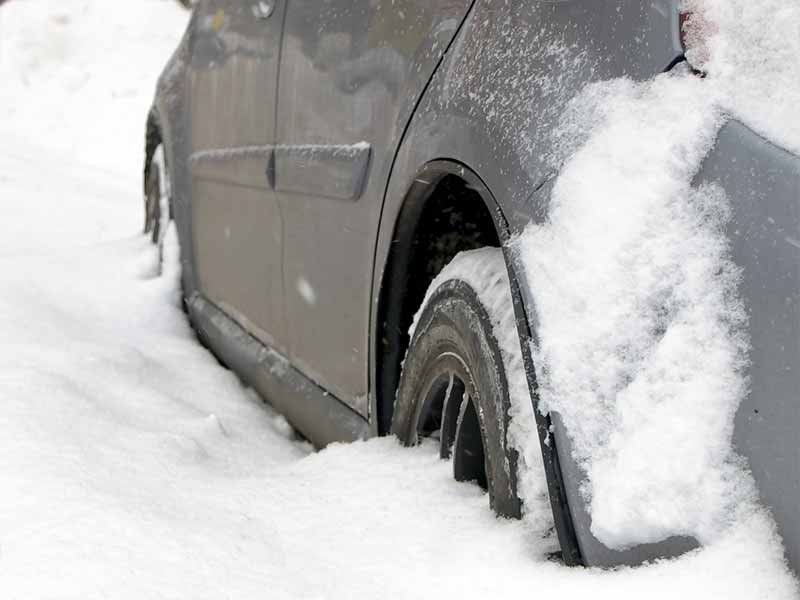Wondering whether tire chains can substitute winter tires for navigating snow-covered roads? Unravel the truth behind this query and discover the optimal choice for your winter driving needs.
Can You Put Chains On All Season Tires?
Yes, tire chains safe for use on all season tires and an excellent choice to provide supplemental traction in unexpected extreme snowy and icy conditions, but they aren’t a complete replacement for winter tires due to specific limitations.
In this article, we dive deep into the world of snow tires versus snow chains for snowy conditions.
We explore the differences between winter tires and all-season tires, discuss their performance in snow, delve into the impact of various vehicle types on tire selection, and evaluate whether chains can truly substitute snow tires.
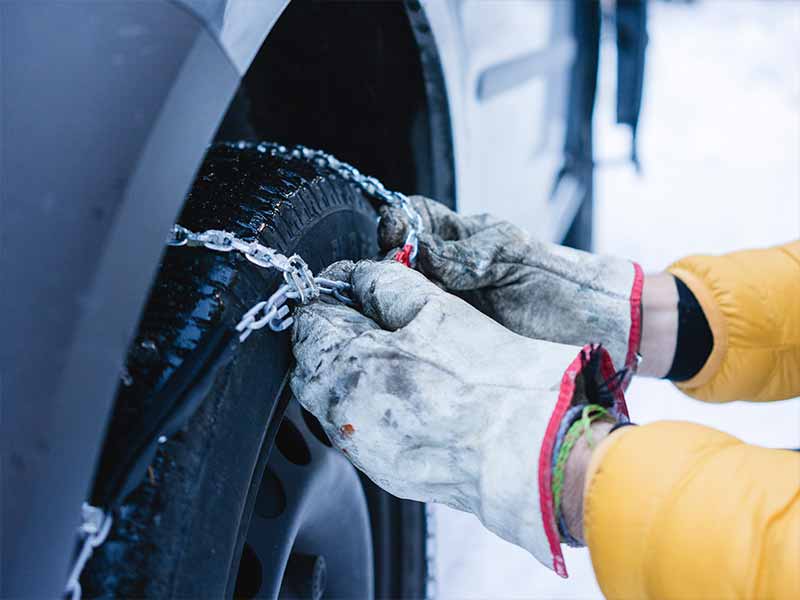
Will Chains Cause Damage to All-Season Tires?
When considering the use of snow chains on all-season tires for extreme winter weather conditions, certain misconceptions regarding potential damage or reduced effectiveness can arise.
Let’s delve deeper into the realities of using chains with all-season tires.
Misconceptions and Clarifications
- Rubber Compound Compatibility: Contrary to common belief, snow chains installed on all-season tires don’t inherently pose a greater risk of tire damage compared to dedicated winter tires. The risk of chains causing damage to the tire’s rubber compound remains relatively consistent across different tire types.
- Tread Pattern Interference: While tread pattern differences exist between all-season and snow tires, the role of chains alters the dynamics significantly. Chains work to provide traction by gripping packed snow and ice directly, lessening the impact of tread pattern differences between tires.
Effectiveness and Improvement
- Enhanced Traction: Tire chains can markedly enhance traction on snow-covered roads and icy surfaces, regardless of the tire type. Their primary function is to dig into the snow and ice, providing significant traction and stability.
- Improved Performance: Contrary to the notion that chains offer limited enhancement, they substantially boost the performance of both all-season tires and winter tires on challenging winter roads. The chains act as a traction aid, effectively augmenting the grip of the tires.
Mitigating Risks and Safety Considerations
- Risk Management: While there are risks associated with using chains, these risks are not significantly amplified when used with all-season tires compared to dedicated snow tires. Proper installation, maintaining secure chain placement while driving, and avoiding excessive speeds are key to minimizing risks associated with tire chain use.
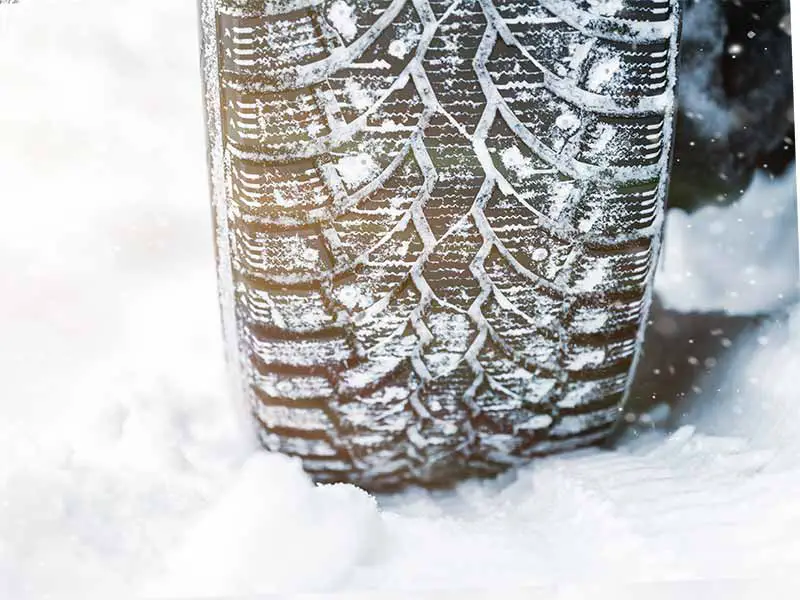
Can Tire Chains Replace Snow Tires?
While snow chains can supplement traction in severe winter conditions, they aren’t a complete substitute for snow tires due to their restricted use and specific application requirements.
Understanding Snow Chains: A Supplemental Traction Solution
Chains are metal chains fitted around tires to enhance traction in snowy and icy conditions. Here’s what you need to know:
- Enhanced Grip: Snow chains significantly improve traction on snow and ice by providing additional grip when driving.
- Limited Applicability: While beneficial in extreme winter conditions, chains have limitations, including reduced effectiveness on clear or dry roads and speed limitations when in use.
Want to learn more about snow chains and their application in snowy conditions? Check out this detailed guide comparing snow tires and tire chains.
Legal Requirements and Considerations
Before relying solely on tire chains for winter driving, it’s essential to understand local tire chain laws and ensure proper installation for safe and effective usage:
- Legal Mandates: Some areas have legal requirements mandating the use of snow chains under certain conditions. Familiarizing yourself with these laws is essential for compliance.
- Safety Considerations: Proper installation and usage of tire chains are vital for safety. Improper installation can damage tires or even pose safety risks.
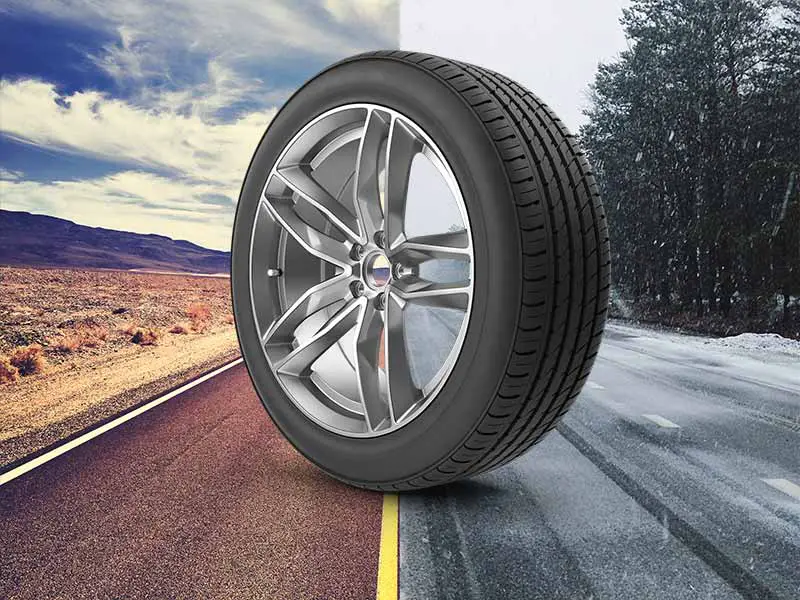
Understanding Winter Tires and All-Season Tires
Let’s look deeper into the specifics of each tire type to understand what sets them apart and how they perform in various weather conditions.
Snow Tires: Designed for Cold and Snow
When it comes to handling chilly temperatures and navigating through snow-covered roads, winter tires stand out for their specialized design. Here’s what makes them a reliable choice:
- Rubber Compound: Snow tires are crafted with a unique rubber compound that remains flexible in cold temperatures. This flexibility ensures better traction on icy and snowy roads.
- Tread Pattern: The tread design of winter tires features deeper grooves and intricate patterns that aid in gripping snow and expelling slush. This design helps enhance traction and reduces the risk of skidding.
- Sipes and Biting Edges: These tires are equipped with extra sipes (tiny slits in the tread blocks) and biting edges that provide additional grip on icy surfaces.
Snow tires are engineered to perform exceptionally well in freezing conditions, offering improved handling, braking, and stability compared to all-season tires. Their ability to maintain traction on snow and ice makes them a wise choice for regions experiencing harsh winter weather.
Want to explore more about winter tires and their benefits? Check out this guide on what winter tires are all about.
All-Season Tires: Versatility Across Different Weather Conditions
On the other hand, all-season tires are designed to provide decent performance throughout the year, catering to various weather conditions, from dry roads to light snow. Here’s what makes them versatile:
- Tread Compound: All-season tires feature a rubber compound that remains flexible in a wide range of temperatures, offering good grip in both hot and cold weather.
- Tread Pattern: The tread design is less aggressive compared to winter tires but includes moderate siping and grooves for handling light snow and channeling water in rainy conditions.
- Balanced Performance: These tires aim for a balance between handling, traction, and durability across different seasons, making them suitable for moderate climates.
While all-season tires provide convenience by eliminating the need for frequent tire changes, they don’t deliver the same level of traction and performance as dedicated winter tires in severe winter conditions.
Curious about how all-season tires work and their limitations in snow? Dive into this guide explaining all-season tire specifics.

When to Put Chains on Tires
Determining the appropriate time to install snow chains can significantly impact safety and traction on snowy or icy roads. Understanding the conditions and regulations for using tire chains is crucial for making informed decisions.
Assessing Weather and Road Conditions
- Snow and Ice Accumulation: The primary trigger for installing snow chains is encountering snow or ice-covered roads where traction becomes compromised. When roads are visibly covered in snow or ice and traction is noticeably reduced, it’s time to consider using chains.
- Slippery Surfaces: If roads are slippery and you experience difficulty maintaining control or notice your vehicle slipping even at low speeds, this is an indication that it might be time to install snow chains for added traction.
Complying with Regulations
- Legal Requirements: Some regions have specific laws mandating the use of chains under certain conditions. Before hitting the road in winter weather, familiarize yourself with local laws and regulations regarding tire chain usage.
- Posted Advisories: Pay attention to any road signs or advisories indicating the necessity of tire chains. These warnings are often posted in areas prone to heavy snowfall or where conditions rapidly deteriorate.
Proactive Preparation
- Pre-Installation Preparation: It’s advisable to practice installing snow chains before heading out in severe winter conditions. Familiarizing yourself with the installation process in a controlled environment can save time and frustration when faced with challenging conditions.
- Early Installation: Consider installing chains before encountering severe conditions to avoid struggling with installation in the midst of a snowstorm or icy roads. Being proactive can ensure safer driving when conditions deteriorate.
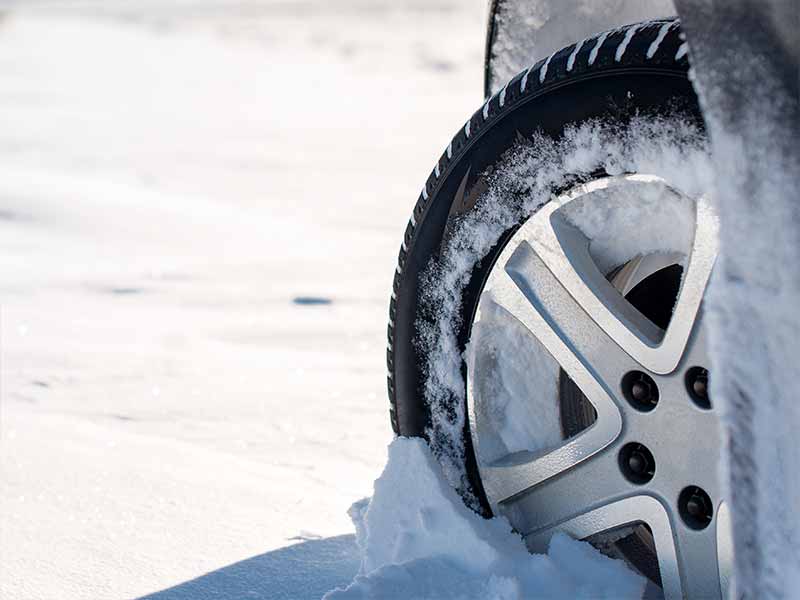
Impact of Chains on Different Vehicle Types in Severe Winter Conditions
Understanding the influence of chains on front-wheel drive (FWD), rear-wheel drive (RWD), and all-wheel drive (AWD) vehicles in severe winter conditions is crucial for optimizing traction and safety.
Let’s explore how snow chains affect these vehicles and how to install them when you only have a pair.
Front-Wheel Drive (FWD) Vehicles
- Tire Chain Impact: FWD vehicles, with the engine’s weight over the front wheels, already benefit from improved traction in snow. Adding tire chains to the front wheels further enhances grip and stability, aiding in maneuvering through snow-covered roads.
- Installation Priority: When only equipped with a pair of chains, it’s advisable to install them on the front wheels of an FWD vehicle. Placing the chains on the driving wheels provides better traction when accelerating and steering, maximizing the vehicle’s handling in snowy conditions.
Rear-Wheel Drive (RWD) Vehicles
- Challenges in RWD Vehicles: RWD vehicles face traction challenges due to power delivery to the rear wheels. Chains, when installed on the rear wheels, significantly improve traction and help mitigate the inherent issues with RWD in snow.
- Installation Guidance: If you possess only a pair of chains, prioritize installing them on the rear wheels of an RWD vehicle. Placing chains on the rear wheels enhances traction during acceleration and prevents fishtailing, ensuring better stability when driving in snowy conditions.
All-Wheel Drive (AWD) Vehicles
- AWD Traction Enhancement: AWD or four wheel drive vehicles distribute power to all wheels, providing better traction inherently. Adding tire chains to an AWD vehicle further augments grip on snow and ice, offering exceptional stability and control.
- Properly Install Chains: In case of possessing only one pair of chains, installing them on both the front or rear wheels of an AWD vehicle is recommended. This balanced approach ensures increased traction and stability, benefiting both acceleration and steering.
Resources
Below are some links you may find helpful when learning about tires:
- Chains for tires 101: When should you use tire chains for cars? – NAPA
- How to: Put on snow chains and drive safely – Les Schwab
Final Thoughts
Understanding the dynamics of using tire chains on all-season tires in severe winter conditions sheds light on their potential benefits and considerations. Tire chains, when installed on all-season tires, can significantly enhance traction and stability on snow-covered roads and icy surfaces.
The combination of tire chains and all-season tires, when use properly, can significantly improve traction, providing an extra layer of safety and control on snowy roads.
Good luck and happy motoring.
